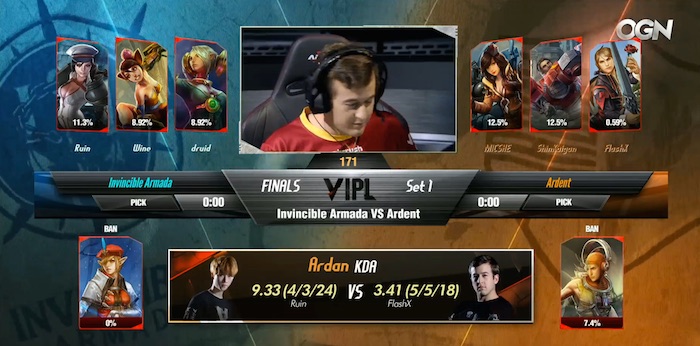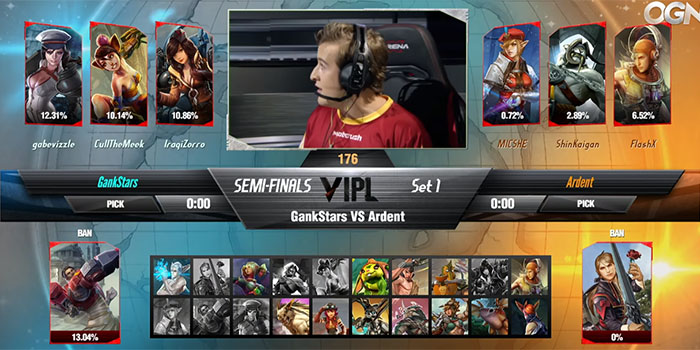As the bar for competitive play in Vainglory continues to get raised, teams need to prepare more effectively by researching opponents and formulating a strategy. In particular, draft mode punishes teams who are unprepared and creates stars out of those who put in the required time and effort. As a player and analyst for a professional team, I want to share some thoughts to help out some of the up and coming competitive teams out there.
For those of you who don’t know me, I’m FlashX. I play the role of roamer for Alliance, the newest champions of the Vainglory International Premier League (VIPL). What I’m about to share is the general process I follow when creating tournament strategies, particularly when you know in advance who your opposition will be. If you need help with general drafting strategy for ranked queue, please refer to this guide.
Team Research
It is important before every competitive match to study your opponent. Some professional teams such as Gankstars or Vertigo have their own analysts who do this on behalf of their players. I personally prefer to do it myself. While I can agree that it takes time away from team preparation, there is a lot of value that comes from the players doing it themselves. As a biology major there’s a lot of science that can support my statement but I can save that for another time.
Things to look for when researching a team:
Comfort Picks
Comfort picks are not inherently a bad thing. It is human nature for players to fall back on whatever makes them feel the most comfortable. However, there is a meta for a reason. The meta changes every update and can even change a few times within a single update. While there are often slight deviations, the meta is often the single most effective composition of heroes in any given update to Vainglory. The meta will often defeat comfort picks and this is a key point in the draft. Knowing hero preferences of your opponents allows one to gain a significant draft advantage.
General Play Style
Understanding a teams play style is also huge. This also does not deviate much from game to game which is why researching your opponents is also important.
- Do they play passively or aggressively?
- Do they rotate a lot? Will they rotate up to lane to gank?
- Do they prefer to farm?
- Should you expect them to invade your jungle?
- On what phase of the game do they make their critical moves: early, mid, or late?
- Do they spend a lot of gold on vision? (aggressive comps can put vision-heavy teams behind)
As an example, if you know a particular team’s strength is playing aggressive, then banning away aggressive, early-game heroes, can be a good decision. If a team likes to play passively and wait for late-game power spikes, you can either ban and/or pick late-game heroes from your opponent or you can draft an aggressive comp that prevents heroes late-game heroes from reaching their potential.
Rotations
Very similar to play style, rotations are another key element of the game.
- Does the laner come down for team fights in the jungle or will he just remain in the lane?
- Does the jungle like to rotate for ganks a lot or do they prefer to fight head on?
- Are there certain times or circumstances under which they rotate?
- Where do they typically perform the rotation (e.g. on their side of the lane or the opposite side)?
As an example, it’s possible that a particular team likes to have their laner rotate at the first jungle invade. A hero such as Ringo might be a good pick because he can either play extremely aggressive and prevent the laner from rotating or he can use his Twirling Silver to rotate faster than the opposing laner, thus ensuring his team has better positioning during the opponents’ rotation.
Vision
Vision is essential in any MOBA. While I’m known for buying much less vision than most other roam players, vision can be the difference in winning or losing a team fight. Against a roam player (or team) who uses a lot of scout traps for vision, drafting an aggressive jungle composition can be a good way to disrupt their vision by frequent invades, causing them to waste their money and put them behind.
Also, there are certain strategic positions throughout the Halcyon Fold that vision is typically used and players do not often deviate from these placements. Studying where your opponents most frequently place scout traps or use flares is important and rotations through the jungle should place an emphasis on negating opponents’ vision.
Objective control
One last aspect is objective control. With the changes to the minion mines in 1.13, and the changes to the jungle in 1.14, objective control will become another highly important dynamic with much greater complexity than previous patches. Understanding how your opponent prefers to manage these objectives depending on their specific draft is of great importance.
- Do they take objectives early?
- Do they prefer to take objectives only after an ace?
- Do they make high risk plays for high potential rewards?
If you know a team will falls off in the late-game due to selecting early-game powerhouses, it is important for them to take objectives earlier to finish the game quicker. If a team composition thrives in the mid-game, a focus on securing the gold mine can be important.
Game knowledge
The meta changes with every patch. Just because a particular hero or team comp is strong during one update, does not mean it will be strong in the next. The Adagio buff, Agent of Wrath, combined with a hero with a high attack speed was phenomenal in 1.11, however it was quite weak in 1.12.
Know which heroes are naturally strong, and which are naturally weak. This can only be established through testing. Just because a hero looks strong or weak on paper, does not mean that is how it will perform in game. This is a natural phenomenon for all MOBA’s; heroes are not, and never will be, equal in strength. While SEMC does a phenomenal job in their balancing, there will never be perfect balance.
Find which strategies are naturally strong and which are naturally weak. Early-game comps were the norm prior to 1.12 when gold bounties were introduced. Teams relied heavily on capitalizing on the early game and snowballing until it was over. With the introduction of gold bounties this is much more difficult to implement. Strategies are always evolving from update to update.
Bring it all together. Combine your comfort picks with naturally strong (meta) picks, and likewise, make draft predictions based upon these assumptions.
Practice drafting
Once I have all the information I need, I begin running simulations.
- Get a piece of paper and build a chart.
- Map out five or six worst case draft paths if we are first pick (we control the initial move)
- Map out eight to ten worst case draft paths if the enemy team has the first ban/pick (this is harder to predict and requires a larger variety of preparation).
While these are just predictions, assume any deviations from these predictions are negligible because they aren’t the best possible strategies. In the highest level of competitive play, comfort picks are NOT the optimal strategy.
As an example of how preparations can play out in a real-world scenario, let’s look at the world finals against Invincible Armada.

- We knew Vox was was a strong comfort pick for their laner. Since we had first ban, we made sure to remove Vox from the picture.
- Having planned for our worst-case scenarios, we expected they might ban Kestrel, as this was ShinKaigan’s best hero and also the current meta.
- Ardan and Skye were two strong picks we wanted to secure. If we first-picked Ardan, they could go Skye/Blackfeather, which no other carries can contest very well. If we first-picked Skye, they could go Ardan + Blackfeather, which would counter Skye in the late-game – and Invincible Armada historically prefers the late-game.
- Based on our knowledge of the EA meta, with Catherine being a more common roam pick, we took a gamble and left Ardan open.
- Lastly, based on Invincible Armada’s track record, we knew they would often comfort pick Celeste for their laner when Vox wasn’t available.
Of course, none of these things could be certain and no strategy is ever perfect, but the probabilities were in our favor and it’s a good example of how all of the drafting preparations can come together successfully.
Practice, Practice, Practice
Simply planning out your worst case scenarios is not enough though. Likewise, obtaining three good or comfortable heroes in a draft is not enough – they might not synergize well. You HAVE to practice these potential comps in ranked queue or in scrimmages against other teams. If you practice a potential draft comp and it has a low success rate, it might not be a viable draft for you and you will have to revise your simulations.
Key Takeaways
- Study the enemy team. Know their strengths and weaknesses. Limit their strengths, capitalize on their weaknesses.
- Study your own team. Ask your teammates what heroes they are comfortable on. Make them practice their strongest heroes in the current meta.
- Know your draft before the draft. It was mandatory in VIPL because you only had 25 seconds to decide on a pick, which doesn’t leave much time for thinking – you need to know what you’re going to do before the day of the game.
- Practice your draft. Your team should be comfortable on all of the different possible draft paths (comps) that were outlined.
I hope you enjoyed reading this article! I am by no means a writer, but hopefully putting my thoughts down on paper will help some developing competitors.
Best wishes,
FlashX


1 Comment
Samarth
Mar 09, 2016 10:30 amHi
Great guide
One question tho
How to get most gold on IGC I see you 1v1 a wp joule vs vertigo black on a ardan